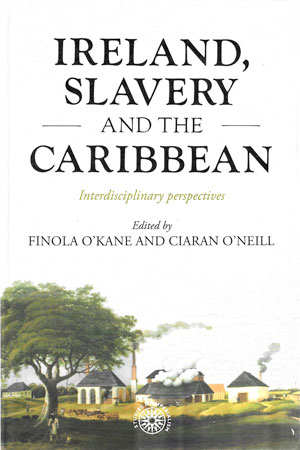
FINOLA O’KANE and CIARAN O’NEILL (eds)
Manchester University Press
ISBN 9781526150998
£90
Reviewed By Sylvie Kleinman
Sylvie Kleinman is Visiting Research Fellow at the Dept of History, Trinity College Dublin.
As the Decade of Centenaries unfolded and transformed the methodologies and outreach strategies of Irish history itself, parallel research was exploring earlier and highly contentious layers of our internationalist past. Ireland has been increasingly positioned as working within and for mercantile empires, and not just as subjugated by British imperialism. Intertwined with the inexorable transnational question of enslavement, race and legacies, unpleasant history must nonetheless be written. Apart from the constant interface with American history, the build-up to the 2007 bicentenary of the UK Slave Trade Act engaged Irish historical scholarship, and the work of Nini Rogers inspired expansion. The very public findings of the Legacies of British Slave-Ownership Project at University College London (UCL) firmly defined a documented research terrain. Irish people engaged in extractive colonialism are traced everywhere, some initially trapped at the lowest levels but often eventually profiting from their ownership and exploitation of enslaved labour. Others interfaced with it as privileged élites. Multiple approaches to the topic, many shaped around the limitations of surviving sources, are ably explored in this multi-layered, erudite but highly readable and ground-breaking book.
The editors open with an extensive, dense and probing discussion, surveying historiography while identifying popular debates. The book is dedicated to David Dickson, who overviews Irish mercantile interests in the 1700s, and one chapter outlines the ongoing analysis of the UCL database, which identifies slave-owners in Ireland or creditors, mortgagees and annuitants with financial claims on the enslaved, c. 1763–1833. Perspectives from colonial history, literature, landscape, architecture and art reveal the extent to which Irish people were present at nearly every level of Caribbean society, starting with governors and planters but descending the social scale to include traders, small retailers and indentured labourers. Most chapters are historical and survey the period from c. 1620 to 1833, when the Caribbean as the ‘crucible of modern capitalism’ experienced extraordinarily rapid development. Very sensitive to public debate, this book explores, demonstrates and deliberately addresses contentious issues. Two revealing chapters are set in the 1600s. One charts the strategies deployed by Catholics in Barbados to successfully enter the emerging racial hierarchy. Rising from perfidious papists, property led to slave-ownership and confessional visibility was minimised. David Brown’s painstaking foray into the free and unfree in Ireland and Barbados, 1620–60, ably contextualises the Cromwellian transportations (1652–5) of Irish who ‘believed they were being enslaved’. His critical tackling of binary oversimplification in the ‘avalanche of recent interest’ is devoid of arrogance. As a robust illustration of ‘the duty of the historian’ in interpreting available evidence, students of any period should read it.
Predictably, the geographical focus across the ocean is most tightly on Jamaica and then Barbados, but restricting research to specifically British territories (the archives of which are evidently in English) is too narrow when developing an Irish perspective. Across many chapters, the mobility of the Irish between British and French imperial territories and the Spanish borderlands in the south of the future United States is investigated. If colonial governors and the plantocracy figure, they do not dominate. Layers of history from below unfold, as soldiers, settlers, slavers, merchants, traders, planters’ agents, brokers, attorneys, priests (often enslavers) and even polyglots (instrumental as translator-interpreters) are contextualised. Finola O’Kane convincingly demonstrates the importance of broadening the scope in an especially probing chapter, exploring the imperial design strategies of Franco-Irish plantations on Saint-Domingue, today Haiti and beset with poverty and upheaval. Saint-Domingue’s records as once the most lucrative slave economy on the globe are preserved in France, and reveal French advances in engineering, cartography, landscape design and colonial governance. The 1640s had led prominent Catholic families (e.g. Walsh, Butler and O’Sheil/Sheill, and O’Rourkes and McNamaras) to emigrate first to France’s Atlantic ports, there to rise in the triangular trade, make lucrative and often inter-Irish marriage alliances, and then live, work and benefit from the plantation system. French digitised cadastral maps partially compensate for the loss or dispersal of family archives, and showcase landscape design that became the Caribbean model in the 1700s. Synchronous mapping (1624) of English fortifications in Ireland and Bermuda stresses how vital imperial military infrastructure was for control, expansion and keeping ahead of Spain. Another richly illustrated comparison links Irish to later Jamaican square-towered and castellated houses built by the English, architectural colonial strategies in contested landscapes.
Natalie A. Zacek provides a sharply contemporary perspective on public debate and identity, deconstructing, inter alia, the ‘Irish slave’ meme in ‘How the Irish became black’. This invaluable publication disentangles the polarities of subjects and agents, insularity and global dynamics.
